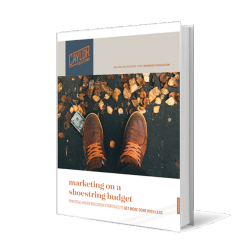Digital Natives and AI: What Higher Ed Can Learn from Gen Z
How can higher ed engage digital natives and cultivate AI fluency at the same time? Conor and Finn Grennan share insights for the next generation of learners.
Featured
As many colleges and universities face declining enrollment, rising tuition costs, and greater competition, more of them are considering drastic measures like a tuition reset.
But enrollment management has become an increasingly complex challenge.
Institutions must not only attract mission-fit students, but also differentiate themselves in a crowded market, balancing affordability with high-quality academic offerings.
One of the most pressing issues today is the financial strain that tuition costs place on students and their families.
This has led many schools to reexamine their pricing models and find innovative ways to make higher education more accessible.
At the same time, schools are competing for the attention of a shrinking pool of prospective students.
Higher education institutions of every stripe have to tackle the underlying issues vexing prospective students and their families.
 One school that has found a way forward in this competitive landscape is Hartwick College.
One school that has found a way forward in this competitive landscape is Hartwick College.
Under the leadership of Dr. Bryan Gross, Vice President for Enrollment Management and Athletics, the college has developed a three-year enrollment strategy that incorporates a significant tuition reset in year two.
In this post, we’ll break down what this tuition reset means for Hartwick College and explore if it is a reasonable strategy for other colleges and universities to adopt.
One of the most innovative pillars of Hartwick College’s three-year higher education marketing strategy is the “tuition reset.”
The reset is a drastic, yet strategic move where Hartwick has lowered its published tuition rates while maintaining, or even enhancing, the quality of education and student experience.
For many colleges, tuition has been rising steadily over the years, leading to sticker shock for prospective students and families.
The high cost of tuition is one of the biggest barriers to college access, especially for students from middle-income families who don’t qualify for significant financial aid but still struggle to afford the rising costs.
Beyond the affordability question is whether or not the current pricing model makes sense to prospective students and their families.
For many years, Hartwick, like many other regional private institutions, has engaged in a “high price, high discount” model. When I arrived, tuition fees, room, board, and other miscellaneous expenses were a little over $70,000, but we were discounting at a high rate.
A key stat in research is that 54% of families will look at a college’s sticker price and based on that sticker price alone, they’ll decide not to apply because they don’t really understand how it works,
Merit scholarships, federal grants, state grants, need-based aid—all of that is an entire confusing thing. For decades, higher ed did well with this “high price, high discount” model.
This opaque pricing model makes it difficult for families—especially those of a first-generation student—to make good educational decisions for their future.
“Over the last seven years,” Gross says, “there’s been a major shift.”
For quite some time now, tuition prices have been rising at a quick pace without much of a pushback on colleges and universities.
“When the demographics were in their favor and when demand was in their favor,” Gross explains, “institutions were able to consistently raise their sticker price year after year.”
At the same time that they would raise their sticker price, colleges and universities would raise their discounts.
This meant that most families did not even know that the sticker price was increasing.
Students responding to these surveys say that higher education costs too much.
In one survey cited in the article, only “7 percent agree higher education institutions, in general, offer good value for what they charge for an undergraduate degree.”
In another survey, close to 70% of respondents said that colleges and universities charge too much when compared to the future earning potential of their degree programs.
The negative feelings have grown to the point where at least one student has filed a lawsuit accusing up to forty institutions of a “price-fixing conspiracy to jack up tuition rates for certain students.”
According to Dr. Gross, the backlash has been caused by a variety of factors.
Declining demographics, unsustainable tuition discounting rate, and change in consumer mindset around the value of higher education.
The idea of a tuition reset [involves] lowering both your sticker price and also lowering your discount.
For Dr. Gross and his leadership team at Hartwick, the tuition reset is a way to respond to this change in consumer mindset by making the pricing model more transparent.
By doing so, they have to slash prices in order to remain competitive.
At the same time, they have to decrease the amount of discounts they are offering in order to remain viable.
In short, the Hartwick tuition reset consists of clarifying the real price of their educational offering, lowering the costs to the student, and minimizing the discounts available.
During our conversation, Dr. Gross insisted that simply slashing costs and prices is not enough.
The real goal of a tuition reset is to attract more applicants. It’s not a magic wand in and of itself.
Just by lowering your price, you’re not going to suddenly increase your enrollment. But the key is if you could pair a tuition reset with a repositioning, as we’ve done at Hartwick College.
Our research found that institutions that have attempted [a tuition reset] just by lowering their price alone and going into the market and talking about “price, price, price” isn’t as compelling in the marketplace as those institutions that are able to do it in a distinctive way.
[Successful schools] talk about their value proposition, which we’re doing at Hartwick.
As a pillar of our marketing strategy, we talk about our price transparency, our clear pricing.
We’re letting families and students know exactly what our costs are, exactly what they can afford to pay. And so far it’s been received really well.
While economic concerns are high on the list of priorities for college bound students and their families, it’s a mistake to think that this is the entirety of what we as marketers should be talking about.
Students need to know the high value they are receiving for the reasonable price that they are paying.
Hartwick College’s tuition reset serves as an inspiring case study for higher education institutions navigating a complex and competitive landscape.
By abandoning the opaque high-cost, high-discount model, Hartwick has not only made college pricing more straightforward but has also repositioned itself as a leader in providing accessible, high-quality education.
Success requires a holistic strategy that highlights the institution’s unique value proposition and reassures families of the lasting benefits of their investment.
For colleges and universities considering this approach, the key takeaway is clear: transparency and affordability must be coupled with a compelling narrative of value.
However, I would recommend taking a highly cautious approach to this strategy.
A tuition reset isn’t the only solution available to higher education leaders who are dealing with what I consider to be the main issue with the tuition problems: transparency.
The high price, high discount model does have its inherent weaknesses.
Among the biggest weaknesses that I see is the confusion that can occur when families are unsure as to the real cost of your educational offering.
This confusion can cause them to hesitate to send their children to your institution or not at all—and that’s a bad thing.
Consider this revealing section in the Inside Higher Ed article.
38 percent of [survey] respondents say the general public underestimates the actual price of college. A Gallup-Lumina Foundation survey found only 23 percent of adults without degrees could guess the cost of a bachelor’s degree within $5,000 of its price tag, highlighting a lack of transparency around costs of higher ed.
The confusion due to the lack of transparency in this pricing model is causing more harm than good in my opinion.
The answer to that question is something that only each school can answer for themselves after a thorough investigation of all the options.
There is no one-size-fits-all answer to the question of the cost of tuition.
All options should be considered before abandoning a long-held pricing strategy like the high cost, high discount model, as Dr. Gross calls it.
However, one thing that we all can do as higher ed marketers is improve our way of communicating about the cost of education.
We can be more clear on the real costs and the real benefits of our degree programs.
And that is something I can say for sure all of us should be doing.
Are Your Communications Clear and Compelling?
As we spoke with Dr. Gross in this full episode of The Higher Ed Marketer podcast, clarity is key in keeping your enrollment marketing strategy strong.
At Caylor Solutions, we offer a strategic enrollment assessment service to help evaluate your current enrollment process strategies, pinpointing inefficiencies and areas for improvement.
It’s like getting that long over-due checkup that you’ve been putting off so that you can get to the key issues holding you back from success.
If you’d like more information on how an enrollment assessment can help you get the clarity you need to move forward, please contact us today!
Set yourself free from your shrinking marketing budget with my popular ebook Marketing on a Shoestring Budget! This ebook is jammed with practical ways to produce high-quality marketing on the cheap.
Inside, I’ll show you proven marketing tactics like…
No hype. No pie in the sky. Just real solutions for getting the job done with the budget you’ve got.
Featured image via hartwick.edu
Subscribe to The Higher Ed Marketer podcast today!